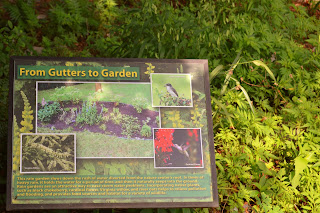Compost Demonstration Area at Hemlock Bluffs
A very helpful and educational little compost area is located behind the classroom building and across from the entrance to the Children's Nature Trail as you walk toward the courtyard from the parking area when you first arrive at Hemlock Bluffs.
Whether you compost at home or not, you'll probably see something new in this area which staff and volunteers have created to use in educating visitors and program participants about compost. The original area has been in place and has been used by staff for educational and hands-on purposes in the gardens, however a recent upgrade was made by a Girl Scout Gold candidate and her troop, family and soccer team. Several different types of compost bins are available for visitors to see and to observe how compost is actually breaking down.
 |
| Recently added, this wire and wood bin is attractive and works very well |
 |
| The staff's favorite, this slat bin is easy to tend because the slats pop out on one side allowing easy access for turning |
 |
| This bin, available online, requires little attention |
 |
| A new experiment this roller type bin spins the compost when you turn it on its glide base |
An educational bulletin board and informational brochure are available right on the wall providing pertinent details about composting, its benefits and how it benefits the environment.
Stop by and take a look next time you are at the preserve!








